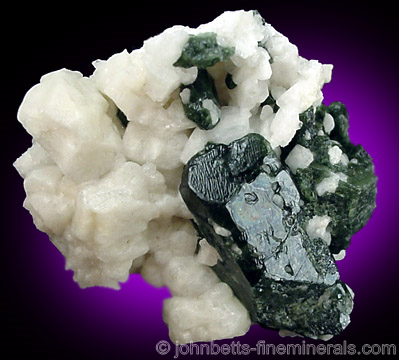The Mineral diopside

Diopside is a very common mineral and forms as an accessory mineral in many environments, and is an important constituent of skarn rocks. Diopside forms a series with Hedenbergite, the iron equivalent of Diopside, and may be partially replaced by it. In fact, Diopside and Hedenbergite can even occur together in a single crystal, with a core of Hedenbergite and outer zone of Diopside. Diopside almost always contains a slight amount of iron replacement, and pure, iron-free Diopside is rather uncommon. Additional iron in the chemical structure of Diopside will cause a darker color and decreased transparency.
For additional information, see the gemstone section on Diopside.
Chemical Formula
CaMgSi2O6
Color
Light to dark green, gray, yellow, light blue, purple, and white. May also be green with thin white streaks running though a crystal. Rarely colorless or multicolored.
Crystal System
Monoclinic
Properties
Streak
White to light green |
Hardness
5 - 6 |
Transparency
Transparent to opaque |
Specific Gravity
3.3 - 3.6 |
Luster
Vitreous, dull |
Cleavage
1,2 - prismatic at cleavage angles of 87º and 93º (Characteristic of minerals in the pyroxene group). May also exhibit parting in one direction. |
Fracture
Uneven to splintery |
Tenacity
Brittle |
Other ID Marks
White forms of Diopside are occasionally fluorescent. |
Crystal Habits
Usually as single, short prismatic crystals. Crystals may also be somewhat elongated, and usually have good terminations. Also massive, grainy, columnar, bladed, radiating, fibrous, as cleavage fragments, and in disordered aggregates of elongated crystals. May also be in v-shaped penetration twins, and crystals from
certain localities have partially hollow or dissolved etchings.
Varieties
-
Emerald green, chromium-rich variety of Diopside.
-
Manganese-rich variety of Diopside. A zinc-rich form also exists, and it may be called "Zinc Schefferite".
-
Light blue to purple, manganese-rich variety of Diopside.
Uses
Diopside creates fine collector specimens, and transparent crystals from the classic localities are highly valued. Diopside is faceted as a minor gemstone, and the emerald-green, chromium-rich Chrome-Diopside variety has been increasing in popularity. Some polished Diopside gemstones display asterism in the form of four-rayed stars.
Noteworthy Localities
Several classic Diopside occurrences are in Italy. Localities there include Val d'Fassa, Trento Province; Val d'Ala and Val d'Ossola, Piedmont; Bellecombe, Val D'Aosta; and Monte Somma, Vesuvius. The purple Violane variety comes from the Prabornaz Mine in Saint-Marcel, Val D'Aosta, Italy.
Important worldwide occurrences of Diopside include Slyudyanka, Lake Baikal area, Russia; the Ziller Tal, Tyrol, Austria; Tulear Province, Madagascar; and a new find of gemmy crystals from the Kunlun Mts, Xinjiang, China. Vivid green Diopside crystals with exceptional transparency come from the Karo Mine, Merelani Hills, Arusha, Tanzania, where it is associated with sharp Graphite plates.
The emerald-green, chromium-rich variety Chrome Diopside comes from several places, specifically Outokumpu, Finland; Konar and Nangharnar Provinces, Afghanistan; Alchuri (Shigar Valley), the Tormiq Valley, and Chamachhu, Skardu District, Pakistan; and Inagli Massif, Aldan, Russia.
In the U.S., the best Diopside localities are in New York. The premier U.S. locality is De Kalb, St Lawrence Co., New York, where this mineral forms in transparent and gemmy light to medium green crystals. Dark, forest-green Diopside with good form and a contrasting white matrix comes from the Rose Road locality, near Pitcairn, also in St Lawrence Co., New York. Very large opaque crystals were found in Orange Co., New York, at Amity and Edenville; and nearby at several of the old iron mines in the Hudson Highlands and Ramapo Mountains region. Other good U.S. localities are Sanford, York Co., Maine; the Belvidere Mountain quarries, Lowell/Eden, Orleans & Lamoille Cos., Vermont; and the Crestmore Quarry, Riverside Co., California.
Canada also has many good deposits for this mineral. Fibrous bundles of Diopside associated with bright-green Grossular comes from Brompton Lake, Quebec. Other famous localities in Canada are the Orford Nickel mine, St-Denis-de-Brompton; Wilberforce and Cardiff, Haliburton Co,. Ontario; Bancroft, Hastings Co.; and the Jefferey Mine, Asbestos, Quebec, where it occurs in a unique tabular, transparent flat crystal form. White Diopside crystals are known from Dog Lake, Frontenac Co., Ontario, Canada.
Common Mineral Associations
Grossular, Vesuvianite, Calcite, Actinolite, Andradite, Wollastonite, Phlogopite, Serpentine, Chlorite, Fluorite, Graphite
Distingushing Similar Minerals
Epidote - Different cleavage, usually darker green, and usually heavily striated
Enstatite - Can be very difficult to distinguish.
Augite - Very difficult to distinguish, although usually darker and less transparent.
Olivine - Different cleavage, occurs in different environments.
Hedenbergite - Usually darker in color, otherwise cannot be distinguished.